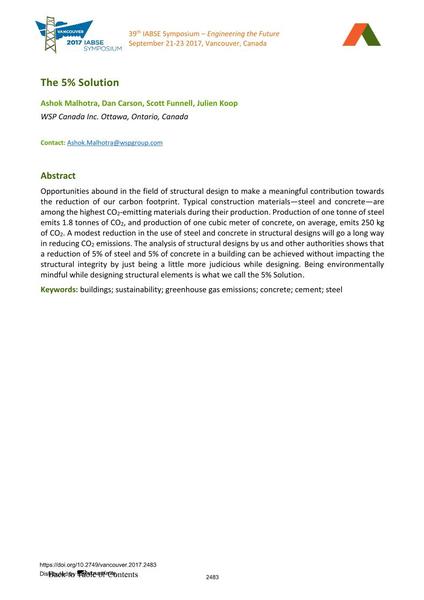The 5% Solution

|
|
|||||||||||
Bibliografische Angaben
| Autor(en): |
Ashok Malhotra
(WSP Canada Inc. Ottawa, Ontario, Canada)
Daniel Carson (WSP Canada Inc. Ottawa, Ontario, Canada) Scott Funnell (WSP Canada Inc. Ottawa, Ontario, Canada) Julien Koop (WSP Canada Inc. Ottawa, Ontario, Canada) |
||||
|---|---|---|---|---|---|
| Medium: | Tagungsbeitrag | ||||
| Sprache(n): | Englisch | ||||
| Tagung: | IABSE Symposium: Engineering the Future, Vancouver, Canada, 21-23 September 2017 | ||||
| Veröffentlicht in: | IABSE Symposium Vancouver 2017 | ||||
|
|||||
| Seite(n): | 2483-2487 | ||||
| Anzahl der Seiten (im PDF): | 5 | ||||
| Jahr: | 2017 | ||||
| DOI: | 10.2749/vancouver.2017.2483 | ||||
| Abstrakt: |
Opportunities abound in the field of structural design to make a meaningful contribution towards the reduction of our carbon footprint. Typical construction materials—steel and concrete—are among the highest CO₂-emitting materials during their production. Production of one tonne of steel emits 1.8 tonnes of CO₂, and production of one cubic meter of concrete, on average, emits 250 kg of CO₂. A modest reduction in the use of steel and concrete in structural designs will go a long way in reducing CO₂ emissions. The analysis of structural designs by us and other authorities shows that a reduction of 5% of steel and 5% of concrete in a building can be achieved without impacting the structural integrity by just being a little more judicious while designing. Being environmentally mindful while designing structural elements is what we call the 5% Solution. |
||||
| Stichwörter: |
Stahl Beton Nachhaltigkeit Gebäude Zement
|
||||
